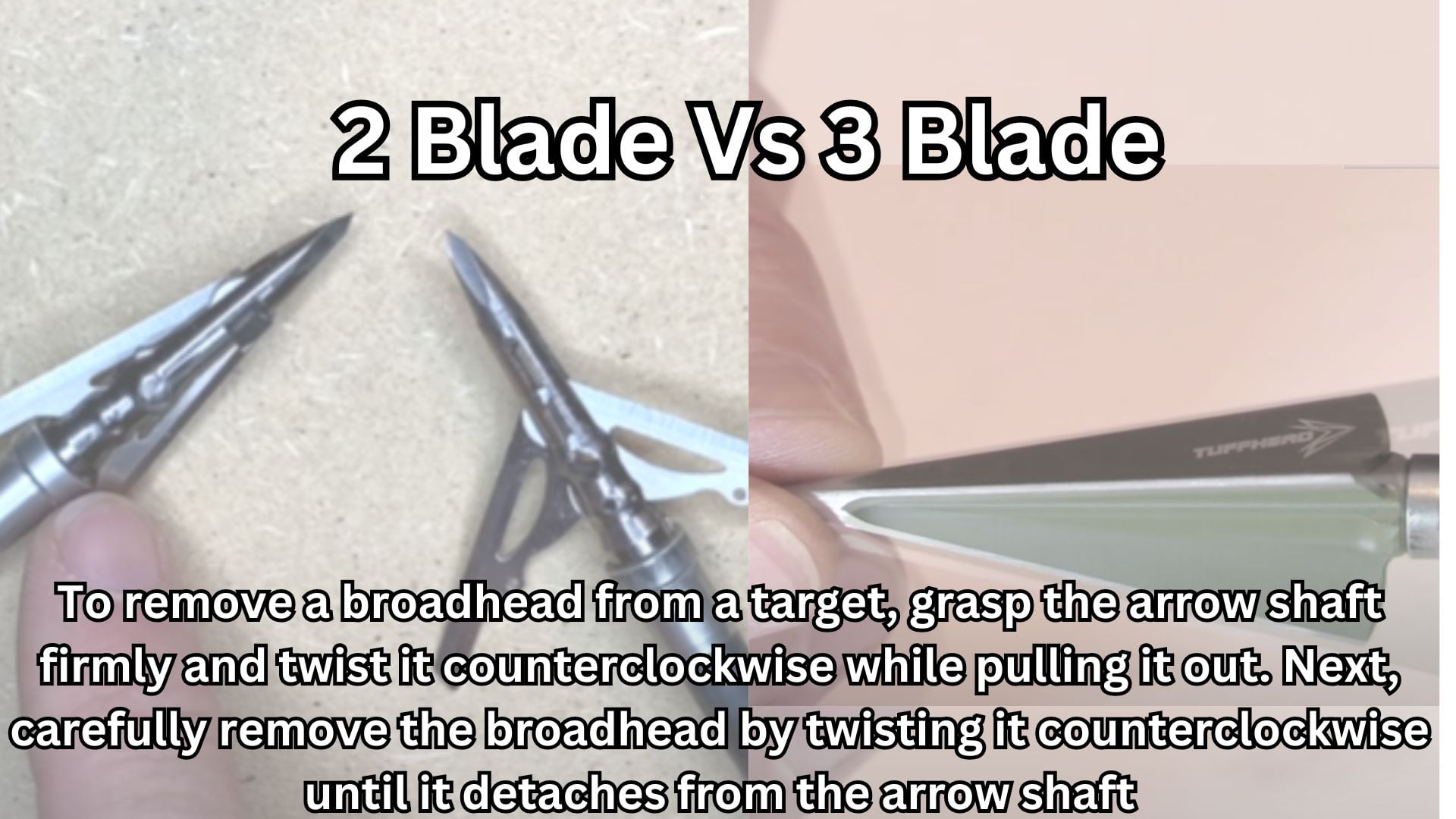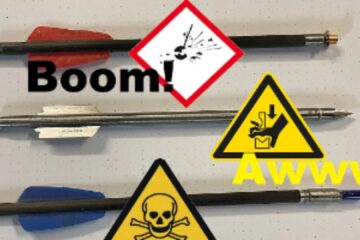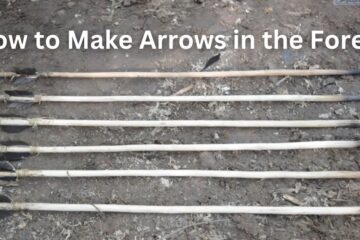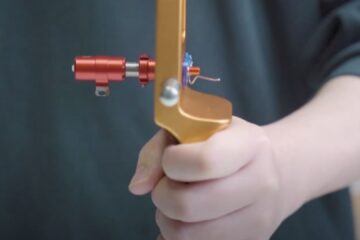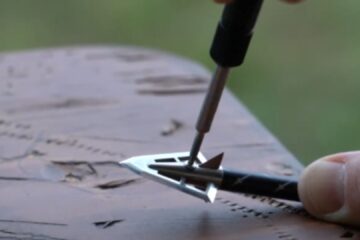The main difference between a 2-blade and a 3-blade broadhead is the number of cutting edges. A 2-blade broadhead has two cutting edges, while a 3-blade broadhead has three.
Choosing between a 2-blade and a 3-blade broadhead depends on various factors, including personal preference, hunting style, and the desired result. 2-blade broadheads are known for their deep penetration and ability to fly straighter, while 3-blade broadheads provide better blood trails and can create larger wound channels.
Ultimately, it is essential to consider your shooting style, game of choice, and desired outcome when choosing between a 2-blade and a 3-blade broadhead. Understanding the differences and advantages of each type can help you make an informed decision for a successful hunting experience.
Understanding Broadheads
Choosing between a 2-blade and a 3-blade broadhead can impact your hunting experience. Understand the key differences to make an informed decision. Explore the pros and cons of each type to find the ideal broadhead for your next hunting adventure.
In the world of archery and bowhunting, broadheads play a vital role in determining the success of your hunt. These razor-sharp tips, designed to inflict maximum damage on game, are attached to the shaft of an arrow. They are specifically designed to cut through the animal’s vital organs, ensuring a quick and humane kill.
Whether you are a seasoned hunter or a beginner, understanding the different types of broadheads and their effectiveness in different hunting situations is crucial. So let’s dive into the world of broadheads and explore what makes them so essential for every hunter.
Explanation Of What Broadheads Are And Their Role In Hunting
Broadheads are specialized arrow tips used in bowhunting. They differ from field points, which are used for target practice, by having razor-sharp blades that cause significant damage upon impact. These blades are fixed or expandable, and they have a vital role in hunting by severing blood vessels and organs, leading to a quick and ethical kill.
Broadheads can be made of various materials, including stainless steel or carbon steel, and come in different shapes and sizes to suit different hunting needs.
Different Types Of Broadheads Available In The Market
When it comes to broadheads, hunters have two main options to choose from: the 2-blade and the 3-blade broadheads. Let’s take a closer look at each type:
2-blade broadheads:
- These broadheads have two main blades that form a cutting edge. They typically have a fixed design, meaning that the blades are permanently attached to the ferrule. The simplicity of their design ensures strength and durability.
Advantages of 2-blade broadheads:
- Penetrate deeper into the target due to the reduced drag caused by fewer blades.
- Create larger wound channels due to their broader cutting edges.
- Ideal for hunting larger game due to their increased cutting power.
- Higher accuracy due to their simplicity and reduced wind resistance.
3-blade broadheads:
- These broadheads feature three main blades that form a cutting edge. They often employ an expandable design, meaning that the blades are housed within the ferrule and open upon impact. This design allows for higher velocity during flight.
Advantages of 3-blade broadheads:
- Offer a larger cutting diameter, enhancing their chances of hitting vital organs and blood vessels.
- Less likely to deflect upon impact, ensuring greater accuracy.
- Create a more significant wound channel, leading to better blood trails for tracking wounded game.
- Suitable for hunters looking for high-impact shock on light or medium-sized game.
Importance Of Choosing The Right Broadhead For Specific Hunting Situations
Selecting the appropriate broadhead for a specific hunting situation is crucial for success in the field. Factors such as the type of game, the desired killing power, and the hunting environment should be considered. Here’s why choosing the right broadhead matters:
Game-specific performance:
- Different game animals have varying sizes and defense mechanisms, requiring different types of broadheads for effective kill shots. Choosing the right broadhead ensures quick and ethical kills, minimizing suffering.
Environmental factors:
- The hunting environment can be diverse, ranging from thick brush and dense foliage to open fields. Broadheads designed for specific hunting situations, such as fixed-blade broadheads for thick vegetation or mechanical broadheads for long-range shots, can offer advantages in these scenarios.
Personal preference:
- Every hunter has their preference and set of skills. Testing different types of broadheads and assessing personal shooting style and accuracy can help determine the most suitable broadhead for each individual.
Choosing the right broadhead for your hunting needs is crucial for achieving clean kills and ensuring a positive hunting experience. Take the time to research, experiment, and match your broadhead to your specific hunting situations, and you’ll increase your chances of success in the field.
Comparing 2 Blade And 3 Blade Broadheads
Comparing 2 Blade and 3 Blade Broadheads is crucial for bowhunters. While 2 blade broadheads offer higher penetration, 3 blade broadheads provide better blood trails and accuracy. Make an informed decision based on your hunting style and preferences.
When it comes to choosing the right broadhead for your hunting needs, understanding the key differences between 2 blade and 3 blade options is essential. Both types have their own advantages and disadvantages, and knowing which one suits your hunting style can make all the difference in your success.
In this section, we will explore the main discrepancies between 2 blade and 3 blade broadheads, as well as outline the pros and cons of each type.
Key Differences Between 2 Blade And 3 Blade Broadheads:
Design:
- 2 Blade Broadheads: These broadheads typically feature just two sharp blades.
- 3 Blade Broadheads: On the other hand, 3 blade broadheads have three blades to slice through the target.
Flight Characteristics:
- 2 Blade Broadheads: Due to their design, 2 blade broadheads are known to have better aerodynamics. They tend to have a flatter trajectory, resulting in a more accurate shot.
- 3 Blade Broadheads: Conversely, 3 blade broadheads have more surface area, which can impact their flight characteristics. They may experience more drag, causing a slightly less accurate shot compared to 2 blade variants.
Penetration and Blood Trails:
- 2 Blade Broadheads: With only two blades, these broadheads often deliver excellent penetration. They create smaller entry and exit wounds, resulting in a more focused blood trail.
- 3 Blade Broadheads: Three blades distribute the cutting force across a wider area, which can result in enhanced wound channels and increased blood trails. However, they may not penetrate as deeply as 2 blade broadheads.
Pros And Cons Of Using Each Type Of Broadhead:
2 Blade Broadheads:
Pros:
- Better aerodynamics and improved flight accuracy.
- Excellent penetration and deeper wound channels.
- Smaller entry and exit wounds for more controlled blood trails.
Cons:
- May require more precise shot placement due to smaller cutting surface.
- Potentially reduced wound size can result in less immediate stopping power.
3 Blade Broadheads:
Pros:
- Wider cutting area leading to larger wound channels.
- Enhanced blood trails, making tracking easier.
- Forgiving shot placement, thanks to increased cutting surface.
Cons:
- Slightly decreased accuracy due to additional drag during flight.
- May not penetrate as deeply as 2 blade broadheads.
Whether you prefer the accuracy and deeper penetration of a 2 blade broadhead or the wider wound channels and improved blood trails of a 3 blade option, it ultimately boils down to personal preference and hunting needs. Both types have their strengths and weaknesses, so it’s important to choose the one that aligns best with your individual hunting style.
Penetration Power And Accuracy
Comparing 2-blade and 3 blade broadheads for better penetration power and accuracy. Which one should you choose? Explore the differences and find the perfect option for your hunting needs.
Discussing The Impact Of Blade Count On Penetration Power:
When it comes to choosing between a 2-blade and 3-blade broadhead, understanding the impact of blade count on penetration power is crucial. Different blade configurations can affect the way an arrow penetrates its target. Let’s take a look at how blade count can influence the overall performance:
Two Blade Broadhead:
- Two blades tend to have a narrower cutting diameter, which can result in deeper penetration.
- The reduced surface area can minimize the amount of drag and friction, allowing the arrow to slice through the air more efficiently.
- With fewer blades, the energy from the arrow is concentrated on a smaller surface area, potentially leading to enhanced penetration power.
- The open wound channel created by two blades can allow for more blood loss, increasing the chances of a quick and lethal kill.
Three Blade Broadhead:
- Three-bladed broadheads typically have a wider cutting diameter, offering increased surface area upon impact.
- The additional blades can create larger wound channels, maximizing the potential damage inflicted on the target.
- The increased surface area may provide more stopping power, especially when striking bone or dense tissue.
- The extra blades can contribute to better stability and accuracy during the arrow’s flight, as they help in balancing the broadhead.
Both options have their advantages, and personal preference often plays a role in the decision-making process. Whether you value deeper penetration or a wider wound channel, understanding the impact of blade count on penetration power is essential in choosing the right broadhead for your needs.
Comparing The Accuracy Of 2 Blade And 3 Blade Broadheads:
When it comes to accuracy, the design and configuration of a broadhead can significantly influence its performance. Let’s compare the accuracy of two blade and three blade broadheads:
Two Blade Broadhead:
- The streamlined profile of a two blade broadhead can promote improved accuracy by reducing drag and improving arrow stability in flight.
- With fewer blades, the overall weight of the broadhead is often lighter, leading to better arrow consistency and enhanced accuracy.
- The simplicity of two blades can result in better alignment and balance, which can translate into improved shot placement.
Three Blade Broadhead:
- Despite having more blades, three blade broadheads can still deliver exceptional accuracy.
- The additional blades can help stabilize the arrow and counteract any potential wobbling during flight, resulting in better overall precision.
- The wider cutting diameter can also provide a larger margin for error, making it easier to hit the target accurately.
Considering accuracy is a key aspect of bowhunting or archery, it is essential to find a broadhead that offers consistent and reliable performance. Both two blade and three blade options have their merits, so it’s important to choose based on personal preference and the specific requirements of your hunting or shooting style.
Wound Channel And Blood Trail
The debate between using a 2-blade or a 3-blade broadhead for hunting centers around the wound channel and blood trail it creates. Each type offers unique advantages and it is important to consider your specific hunting needs and preferences when selecting the right broadhead for your hunt.
Exploring How Blade Design Affects The Size And Effectiveness Of The Wound Channel
When it comes to choosing between a two-blade and a three-blade broadhead, one of the key factors to consider is the wound channel it creates. The wound channel refers to the path that the broadhead’s blades cut through the animal’s tissues upon impact.
The size and effectiveness of the wound channel can have a significant impact on the lethality and tracking of a shot. Let’s explore how blade design plays a role in this aspect.
Blade design determines the width and depth of the wound channel, affecting the amount of damage inflicted on the animal.
Here’s how different blade designs can influence the wound channel size:
- Two-blade broadheads: These broadheads typically have larger blades with a wider cutting surface. They tend to create wider but shallower wound channels. While they may not penetrate as deeply, they can still cause substantial damage, helping in quickly incapacitating the animal.
- Three-blade broadheads: With additional blades, these broadheads create narrower but deeper wound channels. The multiple blades distribute the cutting action over a smaller area, resulting in deeper penetration. This design can be particularly advantageous when hunting larger animals with thick hides and muscle layers.
Discussing The Importance Of Blood Trails In Tracking Wounded Animals
Tracking wounded animals is an essential aspect of ethical hunting. Creating a clear and easy-to-follow blood trail can make the difference between successfully recovering your game and losing it. The choice between a two-blade and a three-blade broadhead can impact the quality and visibility of the blood trail.
Blood trails play a crucial role in tracking wounded animals.
Here are some key reasons why they are important:
- Blood trails provide visual evidence of a hit: Following a shot, a visible blood trail confirms that the broadhead has successfully struck the animal. This confirmation is particularly valuable in scenarios where tracking can be challenging, such as in dense vegetation or low light conditions.
- Blood trails help determine the shot placement: Examining the blood trail can provide insights into where the animal was hit. Factors such as the blood’s color, consistency, and location can guide hunters in understanding whether the hit was in a vital area like the heart or lungs.
- Blood trails aid in tracking a wounded animal: Once a blood trail is identified, it serves as a guide, leading the hunter to the animal’s location. This minimizes the risk of losing the wounded animal and ensures a humane recovery.
When deciding between a two-blade and a three-blade broadhead, understanding how blade design affects the wound channel and the importance of blood trails is crucial. Consider the type of game you’re hunting, shot placement, and your tracking abilities to make an informed choice that aligns with your hunting goals.
Remember, a well-placed shot followed by a clear blood trail can significantly increase your chances of a successful hunt and ethical recovery.
Blade Durability And Replacement
Blade durability and replacement are important factors to consider when choosing between a 2-blade and 3-blade broadhead. The number of blades impacts the cutting surface area and the overall strength of the broadhead, affecting its effectiveness and longevity.
Examining The Durability Of 2 Blade And 3 Blade Broadheads
Blade Durability:
- Both 2 blade and 3 blade broadheads are designed to withstand the impact of hitting a target. However, there are some differences in their durability.
- The durability of a broadhead depends on various factors like the material used, the design, and the quality of construction.
- Generally, 2 blade broadheads are known for their exceptional durability due to their simpler design and fewer components.
- 3 blade broadheads may have slightly less durability compared to 2 blade broadheads because of the additional blade and components.
- Durability is crucial because a broadhead needs to be able to withstand a powerful shot and retain its sharpness for effective penetration.
Blade Replacement:
- Blade replacement is an important aspect to consider when choosing between 2 blade and 3 blade broadheads.
- Both types of broadheads generally allow for easy blade replacement, but there might be slight variations in ease of use.
- For 2 blade broadheads, replacing the blades is usually a straightforward process. Most models have a simple screw-in system that makes blade replacement quick and hassle-free.
- 3 blade broadheads may require a bit more attention when replacing the blades due to the additional components. However, many manufacturers have designed their 3 blade broadheads with user-friendly systems to make blade replacement easier.
- It is essential to carefully follow the manufacturer’s instructions for blade replacement to ensure proper installation and optimal performance.
Both 2 blade and 3 blade broadheads offer durability, but 2 blade broadheads often have a slight edge in terms of durability due to their simpler design. When it comes to blade replacement, both types generally provide an easy process, but it is important to follow the manufacturer’s guidelines for proper installation.
Ultimately, the choice between 2 blade and 3 blade broadheads depends on your personal preference and the specific hunting scenario.
Factors To Consider When Choosing Between 2 Blade And 3 Blade Broadheads
Choosing between a 2 blade and 3 blade broadhead? Consider factors like accuracy, flight trajectory, and penetration. Each has its advantages, so think about your hunting style and game preference. Trust your gut while making a decision.
When it comes to selecting the right broadhead for your hunting needs, choosing between a 2 blade and a 3 blade can be a tough decision. Each type has its own advantages and considerations, so it’s essential to weigh different factors before making a choice.
To help you make an informed decision, this section highlights important factors such as game size, hunting style, and personal preference.
Game Size:
- Larger Game: If you primarily hunt big game like elk or moose, a 3 blade broadhead may be more suitable. The extra blades create a wider cutting area, increasing the chances of hitting vital organs and ensuring a quick, ethical kill.
- Smaller Game: For smaller game like deer or turkey, a 2 blade broadhead might suffice. It offers a smaller profile, which can enhance accuracy and penetration, particularly at longer distances where wind resistance becomes a factor.
Hunting Style:
- Traditional Bowhunting: If you prefer traditional bowhunting techniques, a 2 blade broadhead is often preferred. Its simple design and reduced drag allow for better arrow flight and overall accuracy.
- Compound Bowhunting: If you utilize a compound bow, both 2 blade and 3 blade broadheads can be effective. Consider your shooting abilities and the distance you typically shoot to determine which type best suits your needs.
Personal Preference:
- Penetration vs. Blood Trail: A 2 blade broadhead generally offers maximum penetration due to less surface area. On the other hand, a 3 blade broadhead tends to create a wider wound channel, increasing blood loss and providing a more prominent blood trail. Consider which aspect is more important to you – deep penetration or an easier tracking experience.
- Arrow Speed: The number of blades can impact arrow speed. A 2 blade broadhead has less surface area and may result in slightly higher arrow speeds compared to a 3 blade broadhead. This can be a factor to consider depending on the velocity and kinetic energy you seek.
By taking these factors into account, you can make a well-informed decision about whether to choose a 2 blade or 3 blade broadhead for your hunting adventures. Remember, the right choice ultimately depends on your individual preferences and the specific circumstances of your hunting style and target game.
Take some time to experiment and find the broadhead that aligns with your specific needs to optimize your hunting success.
Testimonials And Expert Opinions
Testimonials and expert opinions provide valuable insights into the debate between 2 blade and 3 blade broadheads, helping hunters make an informed decision. Find out which option performs best for your hunting needs.
When it comes to choosing the right broadhead for bowhunting, there are various options to consider. One of the key decisions is whether to use a 2 blade or 3 blade broadhead. To help you make an informed choice, we have gathered testimonials from hunters who have used both types of broadheads, as well as sought expert opinions from seasoned bowhunters.
So, let’s dive into the experiences and insights of those who have firsthand knowledge of 2 blade and 3 blade broadheads.
Sharing Testimonials From Hunters Who Have Used Both 2 Blade And 3 Blade Broadheads:
- Some hunters prefer the 2 blade broadheads due to their simplicity and ability to maintain momentum in flight.
- One hunter mentioned that the 2 blade broadheads provided deep penetration and clean kills on larger game.
- Another testimony highlighted that the 2 blade broadheads offered excellent accuracy and had a tendency to unerringly find their mark.
- On the other hand, some hunters favored the 3 blade broadheads for their wider cutting diameter and increased blood loss.
- A testimonial mentioned that the 3 blade broadheads created devastating wound channels, making it easier to track and recover the animal.
- Another hunter commented on the 3 blade broadheads’ efficiency in causing quick kills, minimizing the chance of an animal escaping.
Including Expert Opinions On The Topic From Seasoned Bowhunters:
- Seasoned bowhunters have differing opinions when it comes to the choice between 2 blade and 3 blade broadheads.
- Some experts believe that 2 blade broadheads are ideal for shooters who prioritize long-range accuracy and deep penetration.
- These experts emphasize that 2 blade broadheads tend to have lower surface area, resulting in less wind resistance during flight and better trajectory.
- However, other experienced bowhunters argue that the wider cutting diameter of 3 blade broadheads increases the chance of hitting vital organs and blood vessels.
- They suggest that the 3 blade broadheads are particularly effective for hunters aiming to make quick, ethical kills while reducing the risk of animals escaping.
- Ultimately, it boils down to personal preference and the specific hunting scenario, as both 2 blade and 3 blade broadheads have their own advantages.
Testimonials from hunters provide valuable insights into the performance of both 2 blade and 3 blade broadheads. These personal experiences, combined with expert opinions, can guide you toward making an informed decision based on your hunting style and objectives. So, weigh your options and choose the broadheads that align with your needs to maximize your chances of a successful bowhunting experience.
Frequently Asked Questions Of 2 Blade Vs 3 Blade Broadhead
Are 2 Blade Broadheads More Accurate Than 3 Blade Broadheads?
Yes, 2 blade broadheads tend to be more accurate due to their streamlined design and reduced wind resistance. With fewer blades, they also create smaller entry and exit wounds, resulting in better penetration and more effective kills.
Are 3 Blade Broadheads Better For Hunting Larger Game?
Yes, 3 blade broadheads are often preferred for hunting larger game due to their increased cutting surface. The additional blades create more tissue damage, which is crucial for taking down animals like elk or moose. They provide a higher chance of hitting vital organs and maximizing blood loss.
Which Broadhead Type Is More Forgiving On Imperfect Shots?
3 blade broadheads are generally more forgiving on imperfect shots compared to 2 blade broadheads. The extra blades create larger wound channels, increasing the chances of hitting vital areas even if the shot is slightly off-target. This forgiveness can be beneficial in real hunting scenarios where precision may be compromised.
Do 2 Blade Broadheads Offer Better Penetration Than 3 Blade Broadheads?
Yes, 2 blade broadheads often offer better penetration due to their narrower profile. The reduced surface area encounters less resistance and is more likely to pass through the target cleanly. This deep penetration can be advantageous when hunting animals with thick hides or when shooting at longer distances.
Conclusion
After thoroughly examining the differences between 2 blade and 3 blade broadheads, it is clear that both have their own advantages and disadvantages. For those looking for accuracy and aerodynamics, the 2 blade broadheads may be the better choice. With fewer blades, they offer less surface area and are more streamlined, resulting in increased speed and accuracy.
On the other hand, the 3 blade broadheads provide a wider cutting diameter, which can be more effective in creating larger wounds and increased blood trails. Ultimately, the decision between 2 blade and 3 blade broadheads boils down to personal preference and the specific hunting situation.
It is important to consider factors such as the animal being targeted, the desired level of penetration, and the shooter’s skill level. Regardless of the choice made, it is crucial to practice with the chosen broadhead to ensure accuracy and reliability.
With proper technique and practice, both 2 blade and 3 blade broadheads can be effective in taking down game.

